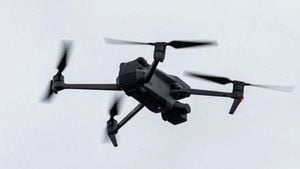Southeast Asia, recognized for its vulnerability to natural disasters, is also notable for the preparedness of its populations when facing such challenges. A recent survey highlights how nations within the region, often struck by earthquakes, typhoons, and floods, not only grapple with these hazards but also believe themselves better equipped to navigate them than those from other parts of the world.
This survey, conducted by Gallup for the Lloyd's Register Foundation, provides contrasting insights about disaster preparedness across various regions. Benedict Vigers, a research consultant, asserted, "Frequent exposure to hazard isn't the only factor determining how prepared people feel."
Receiving high marks for preparedness, the citizens of Southeast Asia reveal confidence influenced by both direct experiences and regional initiatives. For example, nearly 40% of Southeast Asians report having encountered natural calamities within the last five years, yet 67% assert they are well-equipped to keep their families safe.
This optimism is partly attributed to the formidable frameworks established by the Association of Southeast Asian Nations (ASEAN). Investments and collaboration across the region have led to the implementation of effective early warning systems and active community participation, embedding resilience within local cultures.
Interestingly, the survey uncovered varying perceptions of disaster readiness even among affluent regions. North Americans, who experience fewer extreme weather situations, claim they feel similarly prepared compared to their Southeast Asian counterparts, underlining the unique circumstances of each region's context.
The Philippines stands out as the most disaster-affected nation globally, with 87% of respondents reporting firsthand experiences of natural disasters recently. Despite this, it doesn’t remain alone; its neighbors, like Vietnam and Cambodia, also boast impressive disaster planning, with notable proportions of households having emergency plans.
Southeast Asia reveals through these insights how economic status does not solely dictate disaster readiness. Ed Morrow, from the Lloyd's Register Foundation, noted, "Southeast Asia is a region with much to teach the world about preparing for disasters," showcasing their effective responses and communal involvement.
Meanwhile, as the region prepares for potential challenges, the Japan Meteorological Agency continues to warn of dangers following Typhoon No. 7. Moving away from the Kanto-Koshin and Tohoku regions, the typhoon's past fury doesn’t diminish alerts for landslides or severe heat waves looming over the area.
Typhoon No. 7 recently wreaked havoc, leading to intense rainfall and high winds. Lucky for many residents, as the storm system reaches the east-northeast, residents are beginning to recover from the immediate disruptions it caused.
Earlier, during the peak of the typhoon's impact, services like the Tokaido Shinkansen suspension disrupted travel, leading to cramped conditions as trains resumed operations with additional routes added on August 17. With fears of heat strokes following the storm, affecting various prefectures including Tokyo, residents are reminded to stay hydrated and seek shade.
While many people were reassured by the resumption of transport, others remained alert to potential disasters. Disasters leave lasting reminders; for some, they strengthen the community’s resolve to establish solid preparation protocols.
Closer to home, earlier floods have led to calls for nominations for local heroes who assisted during the aftermath of disaster. The Governor-General of Australia has extended invitations for people recognized for their contributions during the 2022 floods to be nominated for the National Emergency Medal.
This initiative acknowledges bravery and community solidarity during hardships. Notably, specific submissions focus on both organization-led efforts and individual assistance.
The medal honors those heroes who risked their safety to assist others amid calamities. It serves as not just recognition but as encouragement for those willing to lend helping hands when their neighbors require urgent aid.
Water management strategies have proven critical within communities prone to flooding. The installation of more efficient drainage systems across Southeast Asia aims to mitigate flooding risks and increase resilience against future storms.
Learning from past events, cities adapt gradually, building upon lessons learned to bolster community investments to stave off imminent disasters. With increasingly severe weather patterns due to climate change, proactive investments have emerged as critical components of local disaster management strategies.
The engagement of communities has amplified awareness about disaster preparedness, illuminating paths for future investments and planning. It reflects how shared knowledge contributes effectively toward readiness, reducing potential loss of life and property during disastrous events.
Local leadership within disaster management generates measurable impacts, focusing on effective training and resource distribution. These approaches establish frameworks within which both government and citizens can collaborate, ensuring awareness about risks and response methods.
Indeed, across Southeast Asia, preparations against frequent disasters become discussions at community gatherings as leaders advocate for responsible initiatives. The combination of grassroots efforts marries institutional resources and planning to yield resilience.
Challenges persist, but so does the resolve among nations within the region to face them head-on. Through community involvement and effective disaster response strategies, residents embody the spirit of preparedness.
Trusting citizens feel their efforts and plans offer brighter prospects for families, cementing faith through repeated experiences of overcoming adversity. The stories of bravery, sacrifice, and optimism fuel what many view as shared identity across the region.
Thus, the ultimate strategy circles through community resilience, ensuring those impacted don’t just endure disasters — they thrive beyond them.



